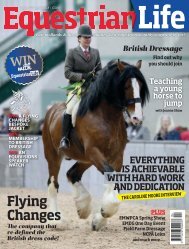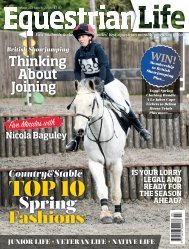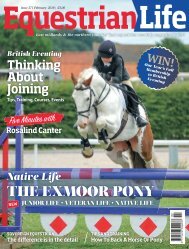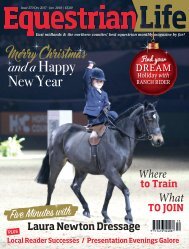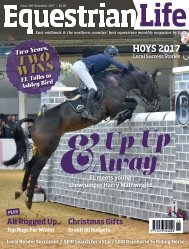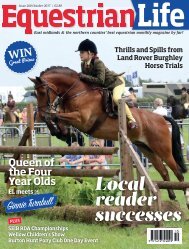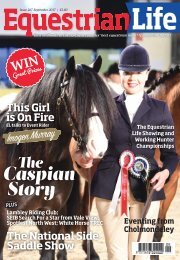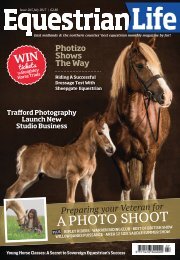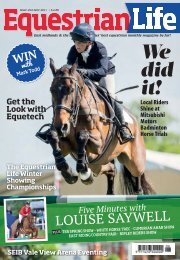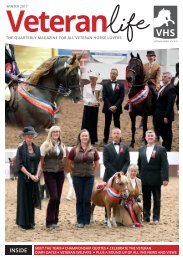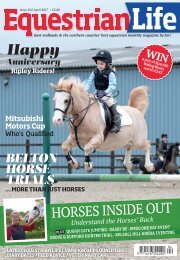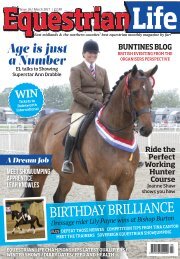Equestrian Life May 2018 Issue
Create successful ePaper yourself
Turn your PDF publications into a flip-book with our unique Google optimized e-Paper software.
RIGHT AND BELOW: Each fence needs to be<br />
approached differently. A tall, upright fence<br />
will require much impulsion and the feeling<br />
of a more ‘bouncy’ canter as the horse sits<br />
and engages the hocks in order for the horse<br />
to make the height. Whereas a wide spread<br />
fence will require more of a forwards pace, in<br />
order for the horse to cover the distance.<br />
an equal distance on the other side. So If<br />
a rider is to take a horse too deep into a<br />
fence this will of increased the distance to<br />
the second part and therefore would need<br />
to make up more room. Likewise if a horse<br />
takes off to early this will decrease distance<br />
so therefore u need to cover<br />
less ground the middle of<br />
the combination.<br />
Whether the jump is set<br />
uphill or downhill also<br />
plays a part in altering a<br />
horses stride. If a jump is<br />
set on a downhill you will be<br />
travelling at a more forward<br />
longer pace. If a jump is<br />
set uphill the canter stride<br />
will be shortened and riders<br />
will have to push in order<br />
to encourage the horse<br />
forwards.<br />
If a jump is set on a<br />
downhill you will be<br />
travelling at a more<br />
forward longer pace<br />
PHOTO BY EQUINATIONAL<br />
Related distances are a test<br />
of a horses training and the<br />
ability to be able to adapt to<br />
a set stride pattern if it does<br />
not match its own. This Is<br />
why flatwork is a crucial part<br />
of a horses schooling to teach the horse to<br />
shorten and lengthern its stride without<br />
resistance or loss of rhythm and balance.<br />
Each fence needs to be approached<br />
differently. A tall upright fence will require<br />
much impulsion and the feeling of a more<br />
‘bouncy’ canter as the horse sits and<br />
engages the hocks in order for the horse to<br />
make the height. Whereas a wide spread<br />
fence will require more of a forwards pace,<br />
in order for the horse to cover the distance.<br />
OTHER FACTORS TO CONSIDER:<br />
• Fences – spooky – is there any colours?<br />
Fillers? Water trays which could make<br />
a horse back off or jump higher than<br />
normal.<br />
• Ground lines. Is there one? Are they out<br />
encouraging a horse to take off sooner or<br />
are they set back which pushes the horse<br />
into the bottom of the fence.<br />
• Ground- is it hard or soft. Look at<br />
ground at take off and landing. Is the<br />
course set on a flat surface or are there<br />
any slopes which will play a part in the<br />
way the horse will travel to a fence and<br />
alter their length of stride.<br />
EXTERNAL FACTORS:<br />
• Sun – is the sun in the horses eyes? Is<br />
there a glare on the floor or on the fence.<br />
These factors could encourage a horse to<br />
back off<br />
• Noises<br />
• Flapping Banners<br />
After you have walked the course stand<br />
back and look at your fences and re run<br />
the course through your mind. If it in an<br />
important competition it can be a good<br />
idea to walk the course at least twice to<br />
really familiarise yourself with the course.<br />
The more courses you are able to walk,<br />
the more familiar you will become with<br />
decision making, judgement of fences and<br />
aware of the type of canter which needs to be<br />
established to each individual fence.<br />
It has taken me many years of course<br />
walking, making mistakes and learning from<br />
them which has enabled me to have great<br />
success within the working hunter industry.<br />
When driving a car, or riding a bike you do<br />
not look at the steering wheel or handle<br />
bars when deciding where to turn… you<br />
look ahead.. The same applies in horse<br />
riding.. turn your head and allow your eyes<br />
to lead you to where u want to go. The<br />
moment you look down you lose forward<br />
movement and wander off your true line.<br />
Another tip is to never be afraid to ask<br />
for help, if you are unsure of something<br />
don’t enter the ring worried and unsure.<br />
Ask someone around who maybe able to<br />
help.<br />
Always remember whilst walking to course<br />
to look smart and where a hat.<br />
www.equestrianlifemagazine.co.uk 37



